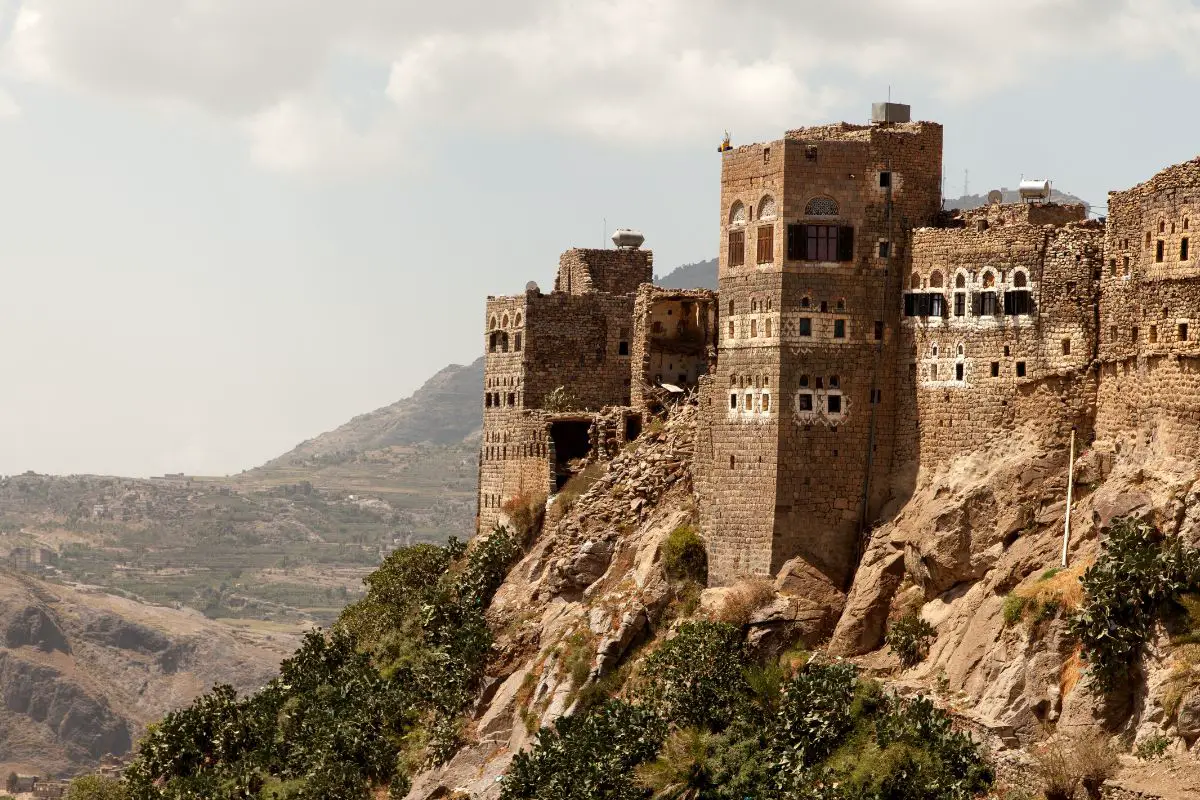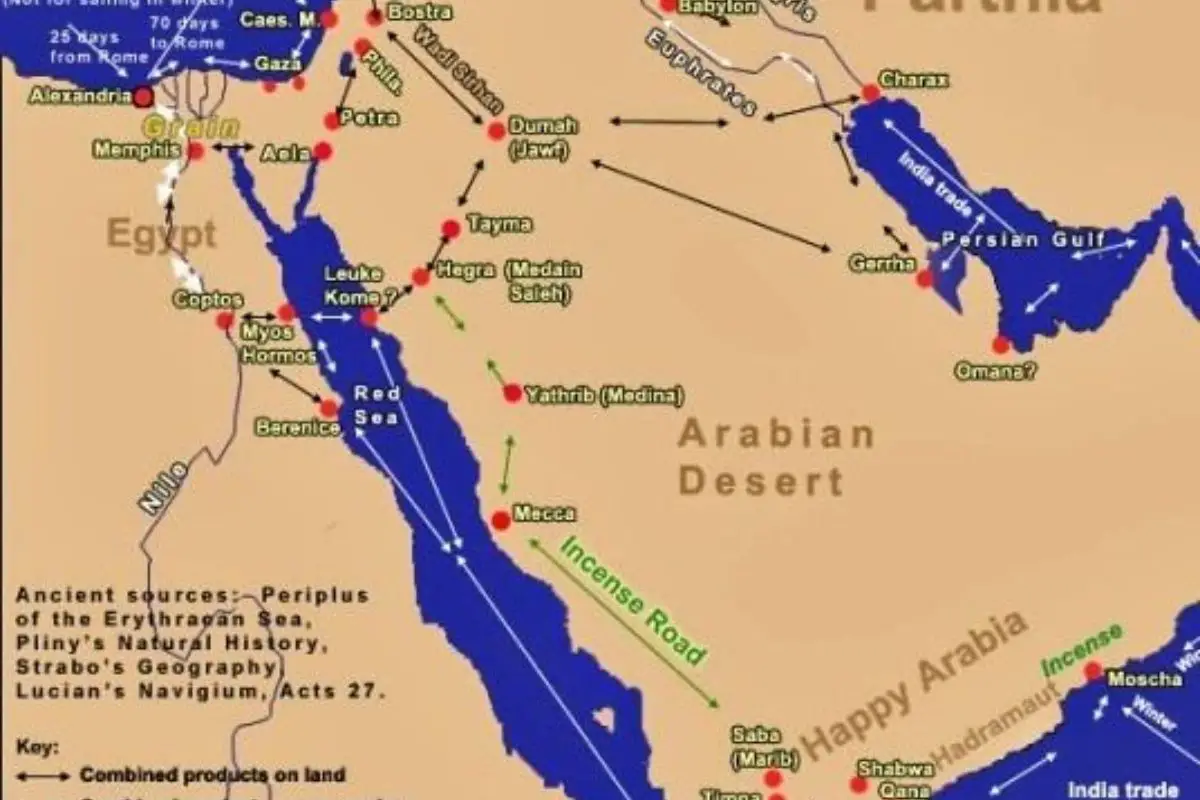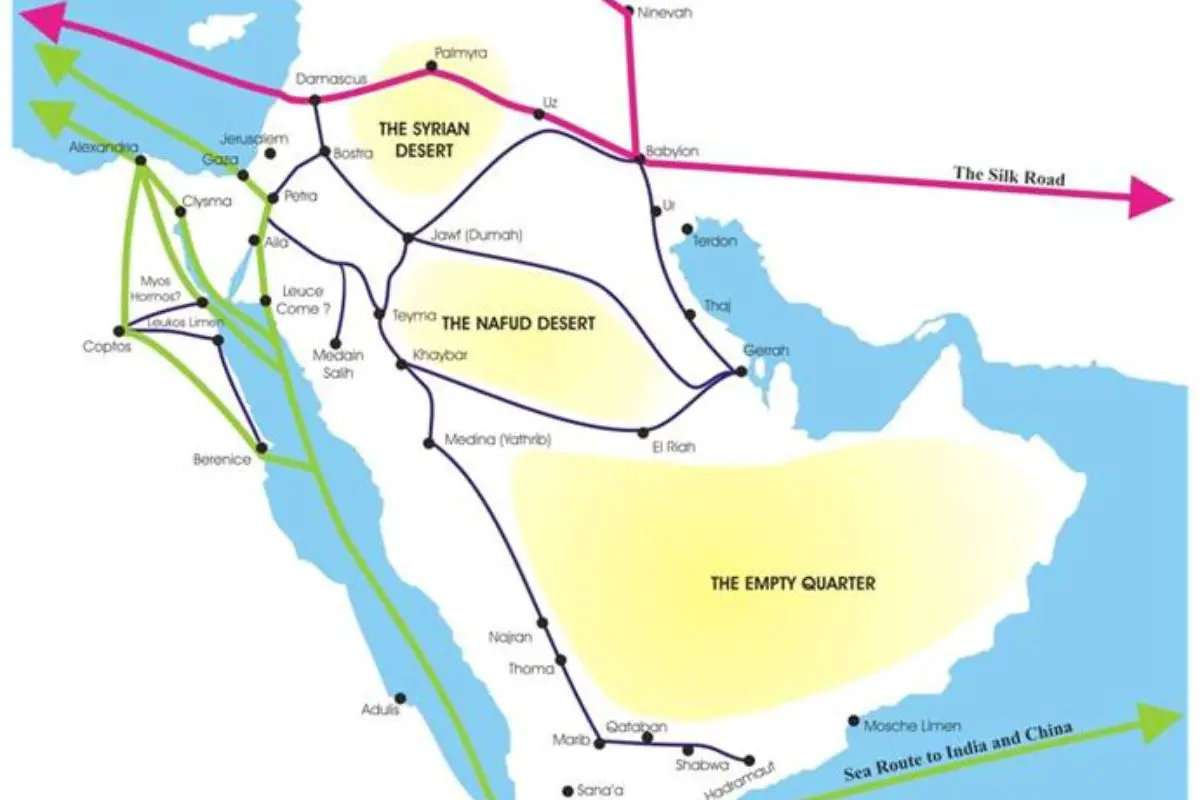In this article, readers will explore the rich history of ancient Yemen and its significant role in world trade. The piece delves into the geographical attributes that contributed to Yemen’s importance, such as its location on the Arabian Peninsula and its abundance of natural resources. The article then describes ancient Yemen’s kingdoms, trade centers, and the famous Incense Route, which was vital for the trade of frankincense and myrrh.
Additionally, the piece highlights Yemen’s role in maritime trade across the Red Sea and Indian Ocean, connecting it to Egypt, South Asia, Southeast Asia, and East Africa—these connections ultimately led to the establishment of strategic ports. The article also looks at Yemen’s involvement in the Silk Road and the impacts of its trade routes on religion, culture, technology, and economic growth in the modern world.

Geographical Overview and Significance of Yemen
Yemen is situated in the southwestern part of the Arabian Peninsula, bordering Saudi Arabia to the north and Oman to the east. The country is flanked by the Red Sea to the west and the Arabian Sea to the south, with its southernmost point jutting into the Gulf of Aden. The geography of Yemen is highly diverse, consisting of distinctive coastal plains, temperate highlands, and vast, arid desert regions. The country’s prominent geographical features include the lofty Haraz Mountains, the large Rub al Khali Desert, and the fertile Tihama coastal plain. The strategic importance of Yemen’s location cannot be overstated, as it has played a pivotal role in shaping its political, economic, and cultural history throughout the centuries.
Natural Resources and Trade Commodities of Ancient Yemen
Ancient Yemen, also known as “Arabia Felix” (meaning “Happy” or “Fortunate Arabia” in Latin), was a flourishing and prosperous region primarily due to its abundance of natural resources and the lucrative trade opportunities that the area offered. The country’s wealth was derived from various agricultural and mineral sources, including the cultivation of frankincense and myrrh trees, as well as the extraction of gold, silver, and precious stones.
Frankincense and myrrh, used in religious and medicinal practices, were highly sought-after commodities in the ancient world. The demand for these fragrant resins led to the establishment of thriving trade routes connecting Yemen to the Greco-Roman world, India, and the Levant. In addition to the incense trade, Yemen was known for its production of fine cotton textiles and its extensive irrigation system, which supported the cultivation of various crops, such as dates, citrus fruits, and grapes.
Moreover, Yemen’s mineral wealth also contributed to its prosperity. The country was rich in precious metals and stones, such as gold, silver, and onyx, which were valued in the jewelry and arts industries of the ancient world.
Strategic Location of Yemen in the Arabian Peninsula
Yemen’s strategic position has made it an important geopolitical player in the Arabian Peninsula and the broader Middle East region for centuries. Its location at the crossroads of Africa, Asia, and Europe has facilitated trade and cultural exchanges, making Yemen accessible to various civilizations over time.
Rendered as a critical juncture along the ancient Spice Route, the Red Sea and the Arabian Sea, Yemen served as a hub for transporting goods from Africa and the Indian subcontinent to the Mediterranean ports. The ancient ports of Qana and Aden, situated on the Arabian Sea and the Gulf of Aden, respectively, were important maritime trading centers that fostered commercial and cultural interactions between merchants from across the ancient world.
Moreover, the southern end of the Arabian Peninsula, where Yemen is located, opens up to the Bab-el-Mandeb Strait. This strategic waterway connects the Red Sea to the Arabian Sea and the Indian Ocean, making it an essential route for maritime trade and military movements. Control over this narrow strait has long been a priority for various empires and nations, as it holds the keys to global maritime commerce.
Yemen’s strategic location has also made it vulnerable to territorial expansion by various neighboring powers, including the Ottoman Empire and more recently, Saudi Arabia and Iran. The country has faced numerous invasions and occupations throughout its history, shaping its boundaries and geopolitical landscape.
In conclusion, Yemen’s geographical position and its wealth of natural resources have played critical roles in shaping the nation’s history and its interactions with the world. Its strategic significance as a major trade hub and the gateway to the Red Sea and the Arabian Sea remains an essential factor in the region’s geopolitical dynamics today.
Ancient Kingdoms and Trade Centers in Yemen

The Kingdom of Saba (Sheba)
The Kingdom of Saba, also known as Sheba, was an ancient kingdom located in the present-day Yemen. It’s believed to have existed between the 12th century BCE and the 3rd century CE. The ancient capital of the kingdom, Marib, was an important trade center, and Saba was a significant player in the incense trade. The kingdom was home to various Semitic-speaking tribes who followed a polytheistic religion.
According to various ancient texts and inscriptions, the Sabaeans were renowned traders and skilled in various fields, such as agriculture, water management, and the construction of monumental buildings. The ancient queen of Sheba or Makeda, mentioned in the Bible and the Qur’an, is said to have ruled over the Kingdom of Saba, and her legendary visit to King Solomon of Israel is a well-known story in both Jewish and Islamic traditions.
The Sabaeans were able to obtain wealth by cultivating and trading in highly valued commodities, such as incense, spices, and precious metals. They controlled the production and distribution of frankincense and myrrh, which were in high demand in the ancient world for religious, medicinal, and cosmetic purposes.
The Kingdom of Hadramawt
The Kingdom of Hadramawt was another ancient kingdom in present-day Yemen. It existed between the 8th century BCE and the 3rd century CE, and had its own distinctive script, known as the Hadrami script. The kingdom’s capital city, Shabwa, was located along the Incense Route and became a major transit point and trade center for the exchange of goods between the East and the West.
Like the Sabaeans, Hadramawt’s economy was based on agriculture, the production of incense, and the trade of valuable commodities like frankincense and myrrh. The kingdom was also known for its skilled craftsmen, who are believed to have invented the technique of blowing glass. Hadramawt’s influence extended as far as the Arabian Peninsula and the Horn of Africa.
The Kingdom of Qataban
The Kingdom of Qataban was another prosperous ancient kingdom in Yemen, which lasted from the 4th century BCE to the 1st century CE. Its capital city, Timna, served as an important trade center along the Incense Route. The inhabitants of Qataban were primarily engaged in agriculture, incense production, and the trade of various goods, including precious metals and gemstones. Qataban was known for its distinctive culture, which was reflected in its architecture, religion, and social customs. The kingdom’s inscriptions reveal that its inhabitants believed in a variety of deities, some of which were unique to Qataban, and others that were shared with neighboring kingdoms.
The Kingdom of Awsan
The Kingdom of Awsan, located in present-day Yemen, was a smaller and less well-known ancient kingdom compared to its neighbors. It existed between the 8th and the 3rd century BCE. The kingdom’s capital, Hagar, was a significant trade center and served as an important stop along the Incense Route. Although the Kingdom of Awsan did not possess vast gold or silver reserves, it was able to accumulate wealth by cultivating and trading in valuable commodities, such as incense, spices, and textiles. The kingdom’s inhabitants were skilled in a variety of crafts, including pottery and metalworking.
Gerrha: An Influential Trade Center
Gerrha was an ancient trade center located on the eastern coast of the Arabian Peninsula, near present-day Bahrain. It was founded around the 4th century BCE by Babylonian exiles and grew in influence during the rise of the Seleucid Empire. Though not a kingdom itself, Gerrha was a major trading center for incense and other valuable commodities from South Arabia and India. The city’s inhabitants were known for their skills in shipbuilding, which allowed them to sail across the Indian Ocean and establish trade connections with the kingdoms of South Arabia.
The Incense Route

Significance of Frankincense and Myrrh
Frankincense and myrrh were highly valued commodities in the ancient world, used for a variety of purposes, including ritual offerings, fumigation, and embalming. They were considered precious and often referred to as “the gifts of the gods.” The Incense Route was an important trade network that stretched from the southern Arabian Peninsula, through present-day Yemen, and up to the Mediterranean, enabling the distribution of these valuable commodities.
Incense Trading Posts
The Incense Route was a vast network, consisting of multiple trading posts and trade centers scattered throughout the Arabian Peninsula, the Levant, and Egypt. These trading centers facilitated the exchange of goods along the Incense Route and eventually connected it to other major trade routes, such as the Silk Road.
Some of the major incense trading posts included Shabwa (Hadramawt’s capital), Marib (Saba’s capital), Timna (Qataban’s capital), and Nashaq (along the Incense Route in present-day Oman). These trading posts enabled the transportation of incense and other valuable commodities, such as precious metals, gemstones, spices, and textiles, to far-flung destinations like Mesopotamia, Egypt, and the Mediterranean.
The Influence of the Incense Route on Local Populations
The Incense Route had a significant impact on the socio-economic and political landscape of the ancient world, particularly on the kingdoms and populations of present-day Yemen. Along the Incense Route, various ancient kingdoms flourished, as their economies and societies were influenced by the constant cross-cultural interactions and the exchange of ideas, beliefs, and artistic styles with foreign merchants, traders, and travelers.
The wealth generated by the incense trade allowed these ancient kingdoms to develop urban centers with sophisticated infrastructure, such as temples, palaces, and fortified walls. In addition, the constant cultural exchange along the Incense Route contributed to the emergence of a hybrid art form and a unique architectural style that combined elements borrowed from neighboring civilizations, such as Egypt, Mesopotamia, and Persia, with local Yemeni traditions.
Decline of the Incense Route
The decline of the Incense Route was a gradual process, which began around the 1st century CE, when the Roman Empire controlled the Mediterranean and northern Africa. The Romans were able to establish direct trade routes with the southern Arabian Peninsula, bypassing the traditional overland routes. Additionally, the discovery and use of alternative sources of incense and the decline in demand for frankincense and myrrh also contributed to the decline of the Incense Route. The decline of the Incense Route, coupled with political upheavals and environmental factors such as the exhaustion of water resources, led to the decline and fall of some of the ancient kingdoms of Yemen, while others managed to survive by adapting to the changing circumstances.
Yemen and the Maritime Trade Routes
Red Sea Trade Route
The Red Sea has always been a significant maritime route connecting the Arabian Peninsula with the Mediterranean Sea and East Africa. In ancient times, this route was used extensively for trade, particularly by the Yemenis, who took advantage of their geographical location to facilitate the exchange of goods. Yemen and Egypt shared a prominent role in the trans-Arabian trade route that connected India and the Mediterranean Basin through the Red Sea.
This trade route brought valuable goods, such as spices, silk, and precious stones from the East to the Mediterranean world, and copper, tin, and other metals from the West to Asia. This mutually beneficial trade fostered political alliances and a rich exchange of ideas, technology, and culture. Trade across the Red Sea between East Africa and Arabia also flourished, linking the civilizations of East Africa with those of the Arabian Peninsula. This maritime route enabled the exchange of valuable goods such as gold, ivory, and slaves from the African hinterland, and spices, incense, and textiles from Arabia.
Indian Ocean Trade Route
The Indian Ocean served as another significant maritime trade route connecting Yemen with the broader world. Various sailing vessels, including the dhow, a traditional Arab sailing vessel, facilitated the transportation of goods across this vast expanse of water. Trade between Yemen and South Asia played a significant role in the development and enrichment of both regions. South Asia was a key supplier of spices, precious stones, textiles, and other luxury goods, while Yemen acted as both a consumer and intermediary in this trade network.
Yemen also exported valuable items, such as frankincense and myrrh, which were in high demand in South Asia. Trade between Yemen and Southeast Asia connected the Far East to the Middle East and beyond. The exchange of goods, such as exotic spices and Chinese porcelain, along with the distribution of knowledge and technology, greatly influenced the economies and cultures of both regions. Yemen’s role in the trade between East Africa and the Indian Ocean further bolstered its status as a prominent economic power. Goods such as gold, ivory, and slaves were traded along this maritime route, enriching the societies involved in this exchange.
Yemen’s Ancient Ports and Their Roles in Maritime Trade
Yemen’s ancient ports played significant roles in facilitating maritime trade. The port of Aden, situated at the southern tip of the Arabian Peninsula, was a major center for the Red Sea trade route. It functioned as a gateway to both the Indian Ocean and the Mediterranean Sea, enabling goods to flow between these critical trade centers.
The port of Mocha, located on the Red Sea coast of Yemen, was another essential trade hub. Known for its coffee exports, Mocha served as a conduit for the exchange of goods between Africa, Arabia, and the wider world. The port of Qana, on the southern coast of Yemen, played a crucial role in Yemen’s participation in the maritime Silk Road. This bustling port facilitated the trade of valuable goods between China and the Middle East and was also instrumental in the dissemination of knowledge and technology across these regions.
Yemen’s Trade Routes and the Silk Road
Yemen and the Land Routes of the Silk Road
The Silk Road, a vast network of trade routes connecting East and West, impacted many societies throughout history, including Yemen. The land routes of the Silk Road extended through the Arabian Peninsula, connecting China and the Roman Empire. Yemen, due to its strategic position at the crossroads of these routes, enjoyed benefits from trade and the exchange of ideas and knowledge throughout the Silk Road network.
Yemen and the Maritime Silk Road
The maritime Silk Road, though less known, played a significant role in facilitating trade between China, Southeast Asia, India, the Middle East, and Africa. Yemen was a vital link in this maritime trade network, with its ports serving as significant hubs for the exchange of goods, technology, and cultures.
Trading Goods Between Yemen and China
Yemen’s role in the Silk Road led to significant exchanges of goods and knowledge between Yemen and China. Yemen imported valuable goods such as silk, porcelain, and tea from China, while exporting frankincense, myrrh, glassware, and other local products to the Far East. This exchange of commodities fostered a rich cultural exchange between the two regions, with the exchange of ideas, knowledge, and technology further intertwining and enriching their civilizations.
Impact of Ancient Yemeni Trade Routes on Modern World

Religious and Cultural Exchange
One of the most significant impacts of Yemen’s participation in ancient trade routes is the resulting religious and cultural exchange. This intermingling of cultures, languages, and beliefs fostered the diffusion of traditions across diverse regions. For instance, the early spread of Islam from the Arabian Peninsula to South Asia, Southeast Asia, and East Africa was facilitated by these trade routes.
Technological and Scientific Advancements
The exchange of knowledge and technology along these historical trade routes laid the foundation for many essential modern advancements. Inventions and discoveries from different civilizations were shared and adapted to solve common problems, such as advancements in navigation, ship-building, and agricultural practices. This cross-fertilization of knowledge and ideas enriched societies worldwide, promoting progress and enhancing quality of life.
Economic Growth and Development
The ancient Yemeni trade routes substantially impacted the economic growth and development of the regions involved. The movement of valuable commodities and resources led to the enrichment of societies, fueling economic growth, and contributing to the evolution of political structures, urban centers, and social hierarchies. These historical exchanges laid the groundwork for modern global trade, shaping our interconnected modern world.
FAQs on the Ancient Trade Routes Connecting Yemen to the Rest of the World
1. What were the main ancient trade routes connecting Yemen to other regions?
The main ancient trade routes connecting Yemen included the Incense Road, the Red Sea trade route, and the Indian Ocean maritime trade network. These routes linked Yemen to Africa, Asia, and the Mediterranean region, facilitating the exchange of goods, knowledge, and culture.
2. Which goods were primarily traded along these ancient Yemeni trade routes?
Yemen was renowned for trading luxury items like frankincense, myrrh, spices, and precious gemstones along these trade routes. Additionally, textiles, ceramics, and other regional products were exchanged, contributing to the flourishing economy and development of Yemeni cities.
3. How did these ancient Yemeni trade routes influence the growth and development of cities in the region?
Cities along the ancient trade routes, like Saba, Ma’rib, and Hadramawt, became thriving centers of trade, industry, and culture. The economic success of these cities enabled the construction of complex infrastructure, such as the Marib Dam, and the emergence of powerful kingdoms across the region.
4. How did these ancient Yemeni trade routes foster cultural exchange and the spread of ideas?
The ancient Yemeni trade routes facilitated interaction among diverse cultures and civilizations. The exchange of goods, knowledge, technologies, and even religions occurred along these routes, which greatly impacted the cultural, social, and religious development of Yemen and other regions.
5. Were the ancient Yemeni trade routes primarily land-based or maritime?
Both land-based and maritime routes connected Yemen to other regions. Overland trade routes like the Incense Road connected Yemen to Africa and the Mediterranean, while maritime networks like the Indian Ocean trade route connected Yemen to South Asia and East Africa.